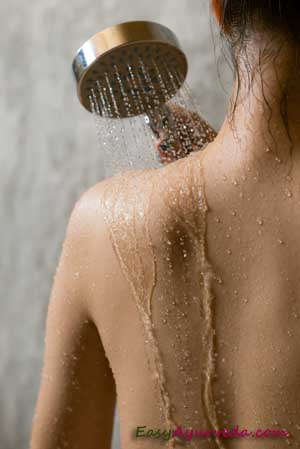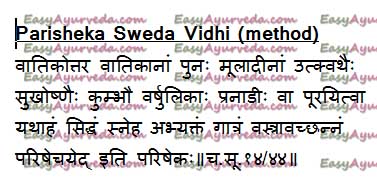Parisheka Sweda – Sudation By Shower – Sprinkling: Method, Health Benefits

Article by Dr Raghuram Y.S. MD (Ay) & Dr Manasa, B.A.M.S
Parisheka means Showering Sprinkling, Spraying
Sweda means sudation, steaming, sweating, fomentation
Parisheka Sweda is a form of Sweating treatment wherein hot or warm Vata or Vata-Kapha balancing medicated liquids like herbal decoction, processed milks, processed buttermilk etc are stream poured or sprinkled over the afflicted part maintaining a constant and uninterrupted flow from a certain pre-fixed height.
Other Names – Seka, Dhara
Table of Contents
Category
Parisheka Sweda is one among the 13 types of Saagni Sweda. Since fire or heatis involved, it will be categorized as Sagni Sweda.
Parisheka Sweda is a drava sweda (liquid sudation or steaming)
Parisheka Sweda is an ardra sweda (wet sudation or sweating method)
Parisheka Sweda can be Sarvanga Sweda i. used allover the body or Ekanga – only on certain body parts.

Parisheka Sweda
Stream pouring or showering the kwathas (decoctions, infusions) → prepared using Vataghna (Vata alleviating) or Vata-Kaphaghna (Vata-Kapha alleviating) herbs → and filled in Kumbhi (small earthen pots), Varshulika (perforated vessels) or Pranadi (tubes), → over the afflicted parts of the body → which have been applied or massaged with vata or vata-kapha alleviating oils → and covered with thin clothes → is called Parisheka Sweda.
Materials and Methods
Swedana Drava –
Hot or warm liquids i.e. processed decoctions etc.
Swedana drava is prepared by processing the vata alleviating or vata-kapha alleviating herbs in water so as to prepare their decoction.
The decoction mentioned in Nadi Sweda shall be used for Parisheka Sweda also. The kwatha shall be prepared as per the method explained in the context of Nadi Sweda.
Apart from Kwatha, the sweda drava used for parisheka can be in one of the below mentioned forms (depends on the preference of material in a given case) –
- Siddha Ksheera – Milk processed with herbs
- Siddha Takra – Buttermilk processed with herbs
- Stanya Dhara – Breastmilk
- Kanji or Dhanyamla – Fermented herbal liquids
- Taila or Ghrita or mixture of both – Medicated oils, ghee or mixture of both
Takra Dhara and Ksheera Dhara – The herbal decoctions may be further processed with milk or buttermilk to prepare the liquid to carry out ksheera dhara (stream pouring of medicated milk) or takra dhara (stream pouring medicated buttermilk) respectively.
Taila Dhara – Parishekam or dhara over painful areas and joints of the body afflicted by vata is also done by using medicated herbal oils like Ksheerabala Taila, Mahanarayana Taila, Mahamasha Taila, Balashwagandha Lakshadi Taila, Murivenna, Kottamchukkadi Tailam etc. In this context, the pariseka will be called as Taila Dhara.
Shirodhara and Sarvanga Dhara – Taila Dhara, Takra dhara and Ksheera Dhara are done over the head when they will be called as Shirodhara. When the same medicaments are used to conduct the dhara all over the body, they will be called Sarvanga Dhara. Kaya Seka or Pizhichil is its variant.
Parishek Yantra
Apparatus for carrying out the parisekam are needed. As per need any one of the Kumbhi, Varshulika or Pranadi is selected.
Kumbhi – Kumbhi is a small pot made up of mud or metals like copper or brass. The vessel is small and convenient enough to hold in the hand and perform parisek. It either has a tapered opening at the top or a tapered opening with small orifice at the bottom fixed with a wick of sterile cotton or cloth or has a small bent tubular extension below the brim of the vessel, towards one side. All these facilities allow uniform flow of medicated liquid in stream. This will also take care that the uniform flow is maintained in a fixed stream. In Shirodhara, the pot is comparatively bigger one and is fixed to a stand such that the wick placed to its lower orifice is at a few inches right on the top of the forehead of the patient sleeping on the dhara table in supine (facing upwards towards the roof) position, with her head rested on the head-rest of the table. For Sarvangadhara, Ekanga Dhara or Parisheka (stream pouring on localized joints and painful parts of the body) etc, the vessel is handled with hand by masseurs.
Varshulika – It is a similar vessel as that of Kumbhi but will have many uniform perforations at the bottom of the vessel. This vessel may be used when sprinkling of swedana drava is preferred to stream pouring (single stream). Alternatively, the vessel will have an extended bent pipe at the neck of the vessel as in Kumbhi, the open end of which (through which parisheka drava flows) will have many perforations (instead of at the bottom).
Pranadi or Pranadika – As the name indicates it is a tubular instrument with a similar arrangement as mentioned in the above mentioned context.
Paricharaka
Paricharaka means attendants or masseurs. A physician can independently conduct ekanga parisheka i.e. parisheka sweda done over a limited area of the body. He may still need a support staff in the form of a single attendant or two, to supply the sweda drava continuously once the pot or vessel gets empty. The parisheka should be kept continuous and done uninterruptedly. When Sarvanga Parisheka (parisheka done for full body) is done 4 masseurs are needed to conduct the treatment, two on the left of the patient and two towards the right and two more helpers.
Sanskrit verse

Procedure
Parisheka Sweda Vidhi (method of conducting Parisheka Sweda)
वातिकोत्तर वातिकानां पुनः मूलादीनां उत्क्वथैः सुखोष्णैः कुम्भौ वर्षुलिकाः प्रनाडीः वा पूरयित्वा यथाहं सिद्धं स्नेह अभ्यक्तं गात्रं वस्त्रावच्छन्नं परिषेचयेद् इति परिषेकः॥च.सू.१४/४४॥
Purvakarma
Agra Sangrhaniya – The medicines, equipments and man-power needed to carry out Parisheka Sweda should be kept ready well in advance to the scheduled time of the treatment.
Abhyanga – Herbal oil massage should be given to the afflicted body parts or the whole body if needed, in case of kashaya or takra or dhanyamla or ksheera parisheka. If sneha dhara or parisheka with medicated oils is being done, Abhyanga need not be done since the oil will anyhow be used in the treatment (with exceptions which may need mild to moderate massage).
Swasthi Vachana – Prayers and chanting should be conducted along with worshipping of God for successful conduct of the treatment and for the welfare of the patient. The patient should also be involved in these spiritual rituals (if willing).
Positioning the patient – The person to be administered with Parisheka Sweda should be taken to Nivata Sthana (room or ward devoid of breeze). He should be made to sit on a comfortable chair (for sthanika parisheka) and made to sleep on the dhara table. The patient should be positioned facing East or North.
Pradhana Karma
Parisheka Prakriya – The medicines should be filled in the Kumbhi or Varshulika or Pranadi. The physician and masseurs should gradually conduct the ekanga or sarvanga parisheka by stream pouring the liquid medicaments on the afflicted body parts or the whole body respectively. It is preferable to take fresh liquid every time for conducting Parisheka. It enhances the effect of parisheka. The method and frequency of change of drava in different contexts have been explained in the related topics.
Related Reading – Takra Dhara, Shirodhara, Kaya Seka or Pizhichil and Sarvanga Dhara
Parisheka Kala – Parisheka can be done for a time period ranging from 30 minutes to 75 minutes and it differs from condition to condition and also differs with the type of parisheka preferred to be done in a given condition. Parisheka can be done at a stretch for 7, 14, 21 or 28 days, this too differs according to the diseased condition and type of parisheka done. Or according to the general principle of swedana, the treatment should be done until proper sweating occurs.
Pashchat Karma
After the completion of Parisheka, the patient should be allowed to relax for a short while. After that Snana (bath) should be provided with warm water. Medicines are prescribed. It is good if Nitya Virechana or daily purgation with vata alleviating herbal purgative oils like Gandharvahastadi Eranda Taila, Nimbamritadi Eranda Taila etc in low doses. This will expel the toxins which have been released into the gut during the process of parisheka. This will also enhance the effect of Parisheka.
Pariharya Vishaya
Below mentioned are the contraindications while one is undergoing Parisheka (these should be kept away):
- Streenaam sparshana darshanam – touching, seeing or thinking about women, indulgence in sex
- Vyaayaama – physical exercises which are strenuous
- Atapa – exposure to heat of the Sun
- Vega Avarodha – forcibly withholding the natural urges of the body (like those of defecation, urination, hunger, thirst, sleep, sneeze etc)
- Hima – exposure to cold, intake of cold food substances
- Dhuma – smoking
- Adhika swapna – excessive sleeping
- Ati uchcha neecha upadhaanaaha – use of high or low level pillows while sleeping
- Raja-Pravata chira kala aaseenatah – standing in dusty areas and cool breezy areas for long time
- Shokam-krodham – grief and anger,
- Jaagarana – keeping awakened late nights
- Pada Yana – walking for long distances,
- Bhashya adhikaan – speaking or shouting in excess
- Ushna Jalopacharya – The person should use hot water for bathing and drinking purposes.
- Na ati bhuk – he should take light diet, should not eat in excess quantity.
- Sadaa brahmacharya – he should follow celibacy
Benefits of Parisheka Sweda
Parisheka Sweda is useful in the below mentioned conditions –
- Vata Rogas – diseases caused by vitiated Vata
- Vata-Kapha Rogas – diseases caused by combined vitiation of vata and kapha
- Pitta Rogas – diseases caused by vitiated pitta but invariably having association with kapha
- Sandhi Shula – Joint pains as in arthritis
- Sandhi Stambha, Gaurava – Stiffness and heaviness in the bony joints
- Kati-Prishta Shula – Pain in the spine, low back
- Mamsagata Vata – Muscle pain, myalgia etc
Other conditions where Parisheka is beneficial –
- Gulma – abdominal tumors
- Anaha – flatulence, distension of abdomen
- Bhagandara – fistula in anus
- Vrana – ulcers and wounds
- Tuni–Pratituni – abdominal disorders (disorders related to urinary disorders) wherein there is there is difficulty in elimination of urine
- Shula – pain, colic
- Abhighata – trauma, injury
- Toda – pricking pain
- Udavarta – upward movement of vitiated vayu
- Kotha – eruptive skin disorders
- Mudhavata (avrita vata) – block in movement of vayu
- Ashteela – prostate hypertrophy
- Visarpa – herpes
- Pleha – splenomegaly
- Aadhmana – distension of abdomen
- Vidradhi – abscess
Other benefits according to types of Parisheka have been explained contextually in related articles of Sarvangadhara, Kaya Seka, Takra Dhara and Dhanyamla Dhara. I have not touched upon those benefits with the fear of trespassing of topics.
Click to Consult Dr Raghuram Y.S. MD (Ayu) – Email / Skype









